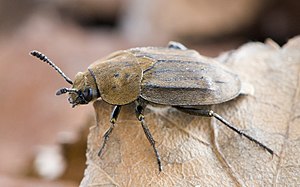Gold-colored beetle beetle
| Gold-colored beetle beetle | ||||||||||||
|---|---|---|---|---|---|---|---|---|---|---|---|---|

Golden beetle beetle ( Aclypea opaca ) |
||||||||||||
| Systematics | ||||||||||||
|
||||||||||||
| Scientific name | ||||||||||||
| Aclypea opaca | ||||||||||||
| ( Linnaeus , 1758) |
The golden or brown beetle beetle ( Aclypea opaca , syn .: Blitophaga opaca ) is a beetle from the family of the carrion beetle (Silphidae). The species is considered a pest on beets in parts of Europe .
features
The beetles reach a body length of 9 to 12 millimeters. They have a black body color, but are tightly covered with fine golden hair, rarely gray haired, occasionally hairless animals are also found. The upper lip is deeply outlined in front (generic feature, difference to the genus Silpha ). The pronotum has two (to six) hairless, shiny spots on both sides of the middle, which can very rarely be missing. The wing covers ( wing covers ) each have three longitudinal ribs, at the end of the third there is a bump, between the ribs they are even and matt due to shallow, even dots. The tarsi are colored red-brown. Those of the males are widened on the first four limbs of the front and middle pairs of legs; in addition, there is a sickle-shaped spine on these pairs of legs at the end of the splints ( tibia ).
Similar species
- Aclypea souverbii with evenly dotted pronotum without hairless, shiny spots. Widespreadonly in alpine locations in the Pyrenees and Carpathians (as well as in the Altai and Sajan Mountains ).
- Aclypea undata with hairless upper surface and pronotum without shiny spots and short-fissured dots on the elytra.
distribution
The animals occur in Europe , in northern Central Asia (south to Mongolia ) and in North Asia , in Siberia north to 62 ° north latitude . In Europe they are particularly common in the north and east, and rare in the west and south. In North America only a small area in the extreme northwest, in Alaska and Northwest Territories , is populated, information further south is based on confusion with the similar Aclypea bituberosa .
Way of life
The adults live in fields and meadows and feed polyphagously on plants such as goose feet , turnips and grasses . The females lay about 120 eggs in the ground over a period of about 45 days. The larvae that hatch are black in color and have a yellow border. Their antennae are rust-red, the legs are yellow-brown. They also have a plant-based diet and especially prefer foxtail plants (Amaranthaceae). They either eat at the edge of the leaves or gnaw holes in them. Pupation takes place in the ground. The new generation hatches in June and prepares for wintering under stones or in dry leaves or forest litter in autumn. The most important predators of the golden beetle beetle include ground beetles , partridge and pheasant .
literature
- Karl Wilhelm Harde, Frantisek Severa and Edwin Möhn: The Kosmos Käferführer: The Central European Beetles. Franckh-Kosmos Verlags-GmbH & Co KG, Stuttgart 2000, ISBN 3-440-06959-1 .
- Edmund Reitter : Fauna Germanica - The beetles of the German Empire. Volume 2 p. 243, KG Lutz, Stuttgart 1912
- Edmund Reitter: Fauna Germanica - The beetles of the German Empire. 5 volumes, Stuttgart KG Lutz 1908–1916, digital library volume 134, Directmedia Publishing GmbH, Berlin 2006, ISBN 3-898-53534-7
- Jiři Zahradnik, Irmgard Jung, Dieter Jung et al .: Beetles of Central and Northwestern Europe. Parey, Berlin 1985, ISBN 3-490-27118-1 .
Individual evidence
- ↑ a b Wolfgang Schawaller (1996): Revision of the genus Aclypea Reitter (Coleoptera: Silphidae). Stuttgart Contributions to Natural History, Series A (Biology) 541: 1-16.
- ↑ Robert S. Anderson & Steward B. Peck (1984): Bionomics of Nearctic species of Aclypea Reitter: Phytophagous "Carrion" Beetles (Coleoptera: Silphidae). Pan-Pacific Entomologist 60 (3): 248-255.